Entrepreneurial Finance: Spatial Technology IPO Failure Analysis
VerifiedAdded on 2023/01/20
|18
|4806
|84
Report
AI Summary
This report examines the financial performance of Spatial Technology Inc. and the reasons behind the lack of investor interest in their 1992 and 1996 IPOs. The analysis includes an executive summary, table of contents, and an introduction to the company and the case study. The core of the report focuses on three valuations (A, B, and C) using different growth rate assumptions to determine the value per share. These valuations are based on the company's revenue, expenses, and financial projections. The report also discusses Spatial's market penetration strategy, the impact of management on the IPOs, and the fair price of shares for potential investors. It concludes with recommendations on how the company could have improved its financial performance and attracted investor interest. The report emphasizes the importance of proper valuation techniques, risk assessment, and aligning capital structure decisions with market conditions and investor expectations.
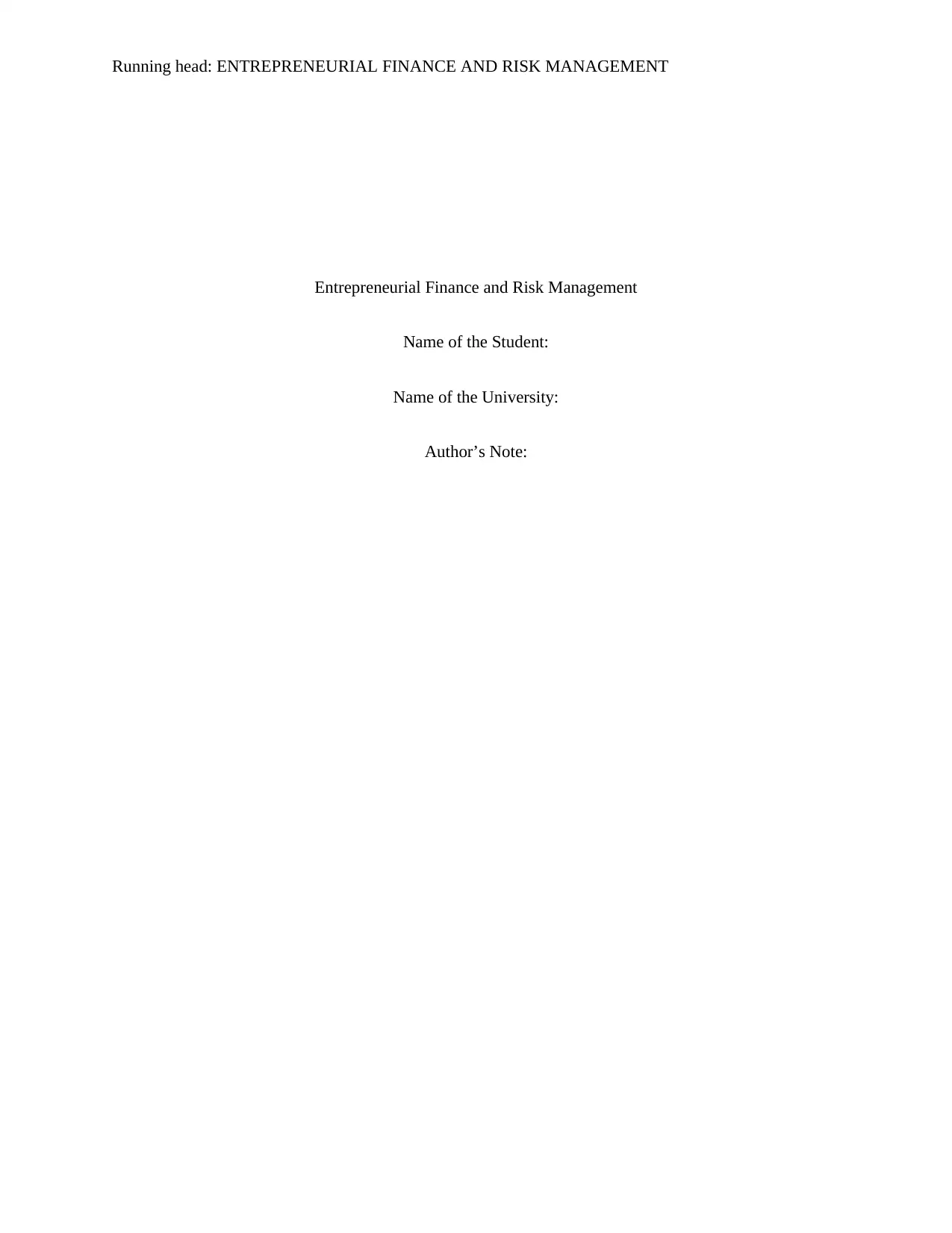
Running head: ENTREPRENEURIAL FINANCE AND RISK MANAGEMENT
Entrepreneurial Finance and Risk Management
Name of the Student:
Name of the University:
Author’s Note:
Entrepreneurial Finance and Risk Management
Name of the Student:
Name of the University:
Author’s Note:
Paraphrase This Document
Need a fresh take? Get an instant paraphrase of this document with our AI Paraphraser
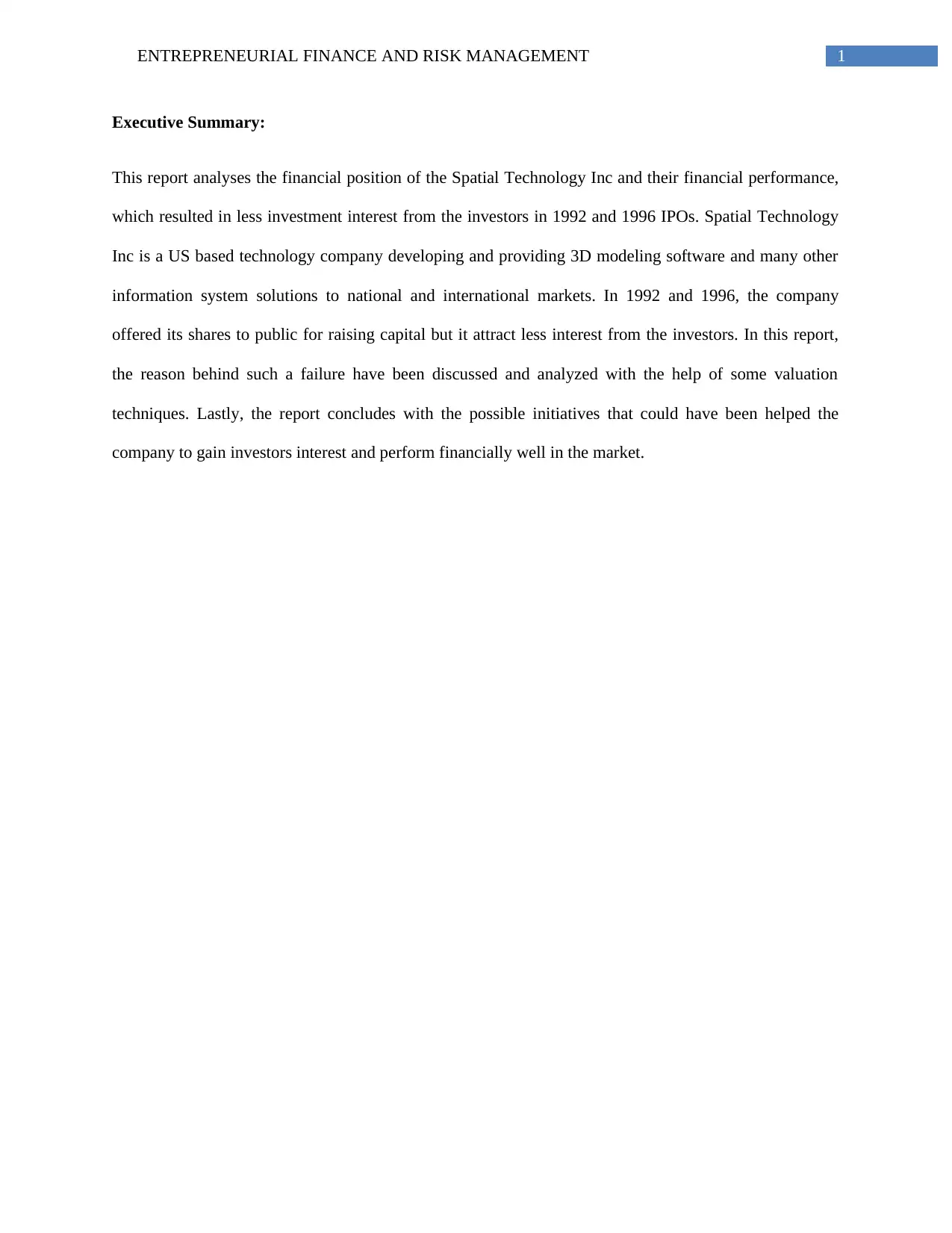
1ENTREPRENEURIAL FINANCE AND RISK MANAGEMENT
Executive Summary:
This report analyses the financial position of the Spatial Technology Inc and their financial performance,
which resulted in less investment interest from the investors in 1992 and 1996 IPOs. Spatial Technology
Inc is a US based technology company developing and providing 3D modeling software and many other
information system solutions to national and international markets. In 1992 and 1996, the company
offered its shares to public for raising capital but it attract less interest from the investors. In this report,
the reason behind such a failure have been discussed and analyzed with the help of some valuation
techniques. Lastly, the report concludes with the possible initiatives that could have been helped the
company to gain investors interest and perform financially well in the market.
Executive Summary:
This report analyses the financial position of the Spatial Technology Inc and their financial performance,
which resulted in less investment interest from the investors in 1992 and 1996 IPOs. Spatial Technology
Inc is a US based technology company developing and providing 3D modeling software and many other
information system solutions to national and international markets. In 1992 and 1996, the company
offered its shares to public for raising capital but it attract less interest from the investors. In this report,
the reason behind such a failure have been discussed and analyzed with the help of some valuation
techniques. Lastly, the report concludes with the possible initiatives that could have been helped the
company to gain investors interest and perform financially well in the market.
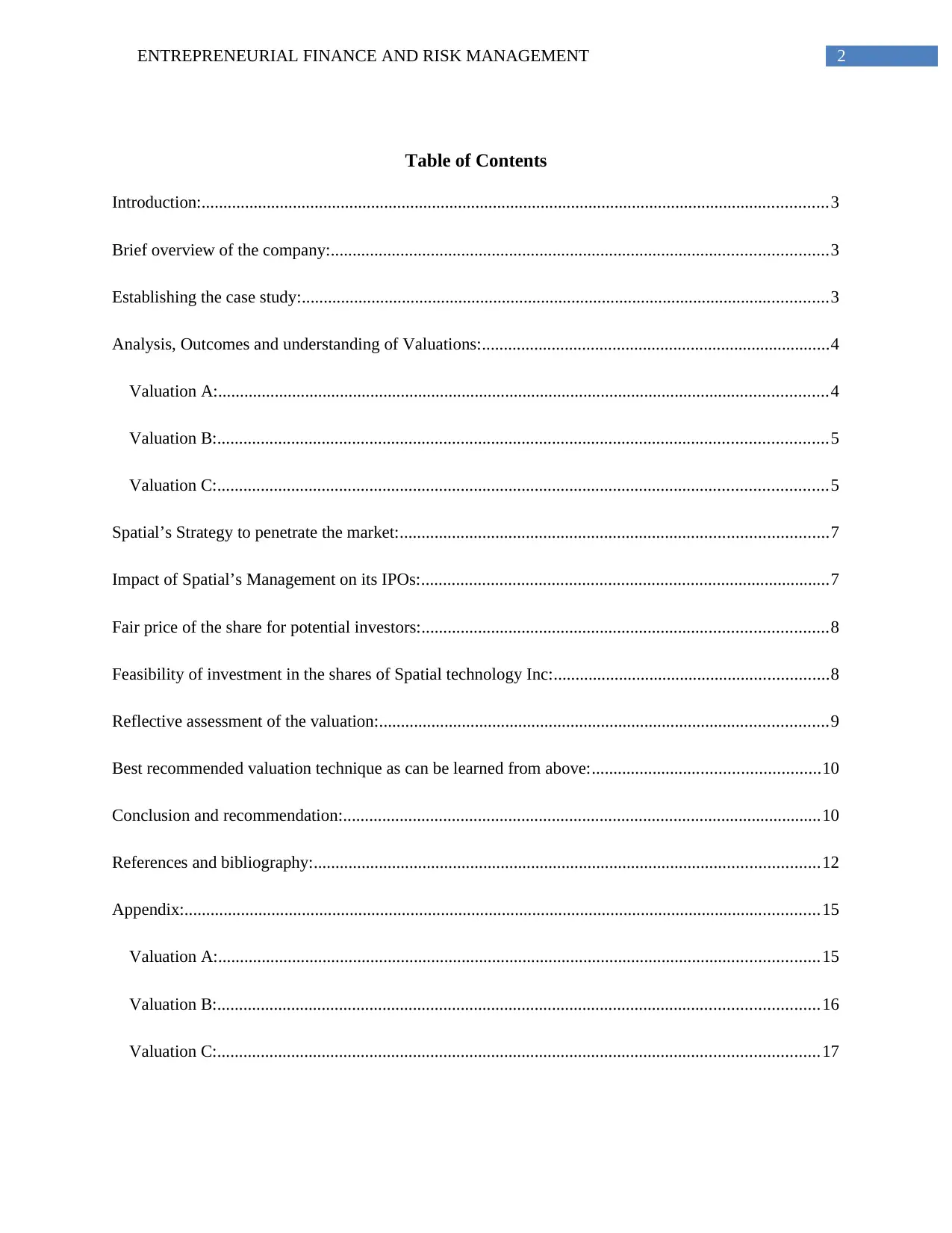
2ENTREPRENEURIAL FINANCE AND RISK MANAGEMENT
Table of Contents
Introduction:................................................................................................................................................3
Brief overview of the company:..................................................................................................................3
Establishing the case study:.........................................................................................................................3
Analysis, Outcomes and understanding of Valuations:................................................................................4
Valuation A:............................................................................................................................................4
Valuation B:............................................................................................................................................5
Valuation C:............................................................................................................................................5
Spatial’s Strategy to penetrate the market:..................................................................................................7
Impact of Spatial’s Management on its IPOs:..............................................................................................7
Fair price of the share for potential investors:.............................................................................................8
Feasibility of investment in the shares of Spatial technology Inc:...............................................................8
Reflective assessment of the valuation:.......................................................................................................9
Best recommended valuation technique as can be learned from above:....................................................10
Conclusion and recommendation:..............................................................................................................10
References and bibliography:....................................................................................................................12
Appendix:..................................................................................................................................................15
Valuation A:..........................................................................................................................................15
Valuation B:..........................................................................................................................................16
Valuation C:..........................................................................................................................................17
Table of Contents
Introduction:................................................................................................................................................3
Brief overview of the company:..................................................................................................................3
Establishing the case study:.........................................................................................................................3
Analysis, Outcomes and understanding of Valuations:................................................................................4
Valuation A:............................................................................................................................................4
Valuation B:............................................................................................................................................5
Valuation C:............................................................................................................................................5
Spatial’s Strategy to penetrate the market:..................................................................................................7
Impact of Spatial’s Management on its IPOs:..............................................................................................7
Fair price of the share for potential investors:.............................................................................................8
Feasibility of investment in the shares of Spatial technology Inc:...............................................................8
Reflective assessment of the valuation:.......................................................................................................9
Best recommended valuation technique as can be learned from above:....................................................10
Conclusion and recommendation:..............................................................................................................10
References and bibliography:....................................................................................................................12
Appendix:..................................................................................................................................................15
Valuation A:..........................................................................................................................................15
Valuation B:..........................................................................................................................................16
Valuation C:..........................................................................................................................................17
⊘ This is a preview!⊘
Do you want full access?
Subscribe today to unlock all pages.

Trusted by 1+ million students worldwide
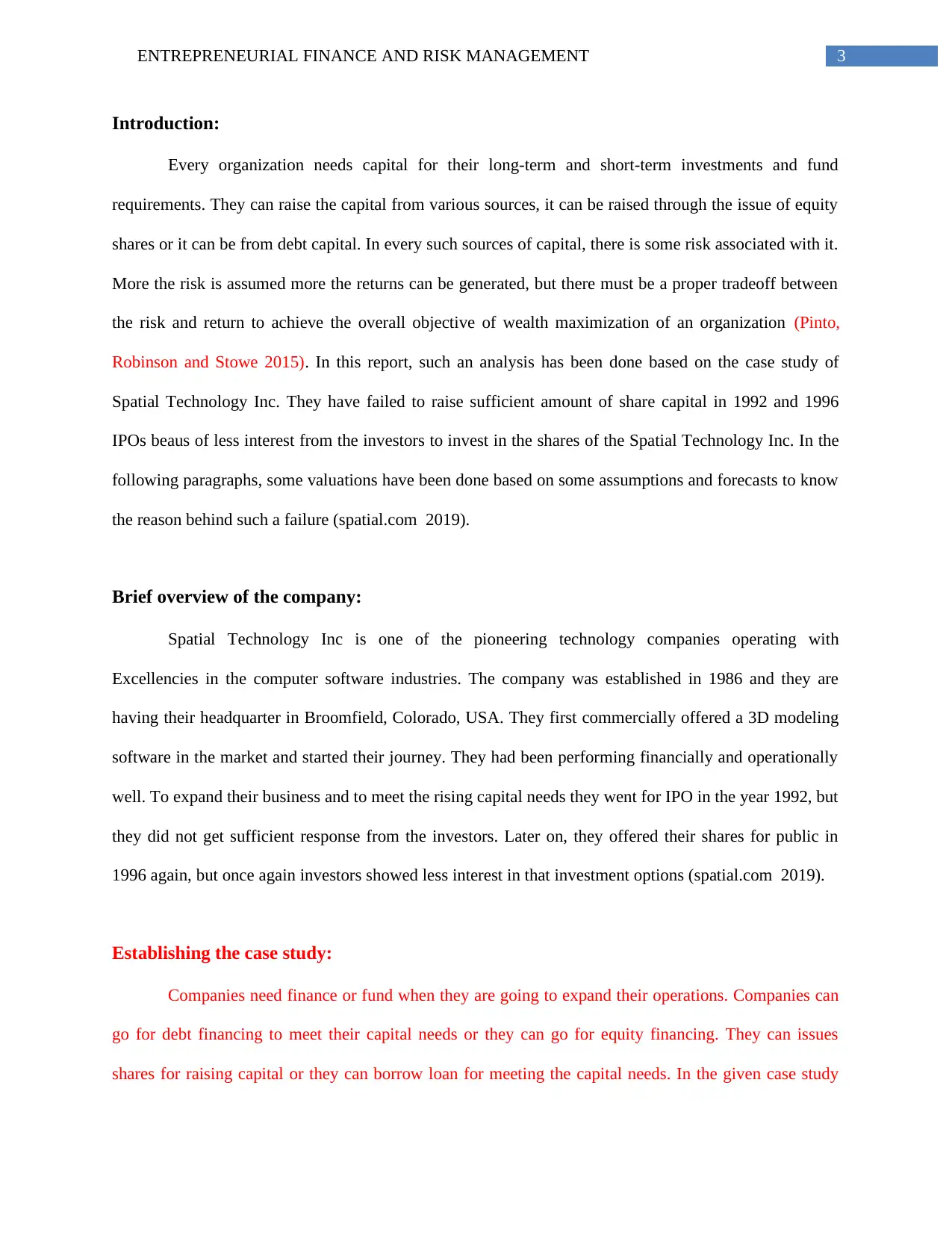
3ENTREPRENEURIAL FINANCE AND RISK MANAGEMENT
Introduction:
Every organization needs capital for their long-term and short-term investments and fund
requirements. They can raise the capital from various sources, it can be raised through the issue of equity
shares or it can be from debt capital. In every such sources of capital, there is some risk associated with it.
More the risk is assumed more the returns can be generated, but there must be a proper tradeoff between
the risk and return to achieve the overall objective of wealth maximization of an organization (Pinto,
Robinson and Stowe 2015). In this report, such an analysis has been done based on the case study of
Spatial Technology Inc. They have failed to raise sufficient amount of share capital in 1992 and 1996
IPOs beaus of less interest from the investors to invest in the shares of the Spatial Technology Inc. In the
following paragraphs, some valuations have been done based on some assumptions and forecasts to know
the reason behind such a failure (spatial.com 2019).
Brief overview of the company:
Spatial Technology Inc is one of the pioneering technology companies operating with
Excellencies in the computer software industries. The company was established in 1986 and they are
having their headquarter in Broomfield, Colorado, USA. They first commercially offered a 3D modeling
software in the market and started their journey. They had been performing financially and operationally
well. To expand their business and to meet the rising capital needs they went for IPO in the year 1992, but
they did not get sufficient response from the investors. Later on, they offered their shares for public in
1996 again, but once again investors showed less interest in that investment options (spatial.com 2019).
Establishing the case study:
Companies need finance or fund when they are going to expand their operations. Companies can
go for debt financing to meet their capital needs or they can go for equity financing. They can issues
shares for raising capital or they can borrow loan for meeting the capital needs. In the given case study
Introduction:
Every organization needs capital for their long-term and short-term investments and fund
requirements. They can raise the capital from various sources, it can be raised through the issue of equity
shares or it can be from debt capital. In every such sources of capital, there is some risk associated with it.
More the risk is assumed more the returns can be generated, but there must be a proper tradeoff between
the risk and return to achieve the overall objective of wealth maximization of an organization (Pinto,
Robinson and Stowe 2015). In this report, such an analysis has been done based on the case study of
Spatial Technology Inc. They have failed to raise sufficient amount of share capital in 1992 and 1996
IPOs beaus of less interest from the investors to invest in the shares of the Spatial Technology Inc. In the
following paragraphs, some valuations have been done based on some assumptions and forecasts to know
the reason behind such a failure (spatial.com 2019).
Brief overview of the company:
Spatial Technology Inc is one of the pioneering technology companies operating with
Excellencies in the computer software industries. The company was established in 1986 and they are
having their headquarter in Broomfield, Colorado, USA. They first commercially offered a 3D modeling
software in the market and started their journey. They had been performing financially and operationally
well. To expand their business and to meet the rising capital needs they went for IPO in the year 1992, but
they did not get sufficient response from the investors. Later on, they offered their shares for public in
1996 again, but once again investors showed less interest in that investment options (spatial.com 2019).
Establishing the case study:
Companies need finance or fund when they are going to expand their operations. Companies can
go for debt financing to meet their capital needs or they can go for equity financing. They can issues
shares for raising capital or they can borrow loan for meeting the capital needs. In the given case study
Paraphrase This Document
Need a fresh take? Get an instant paraphrase of this document with our AI Paraphraser
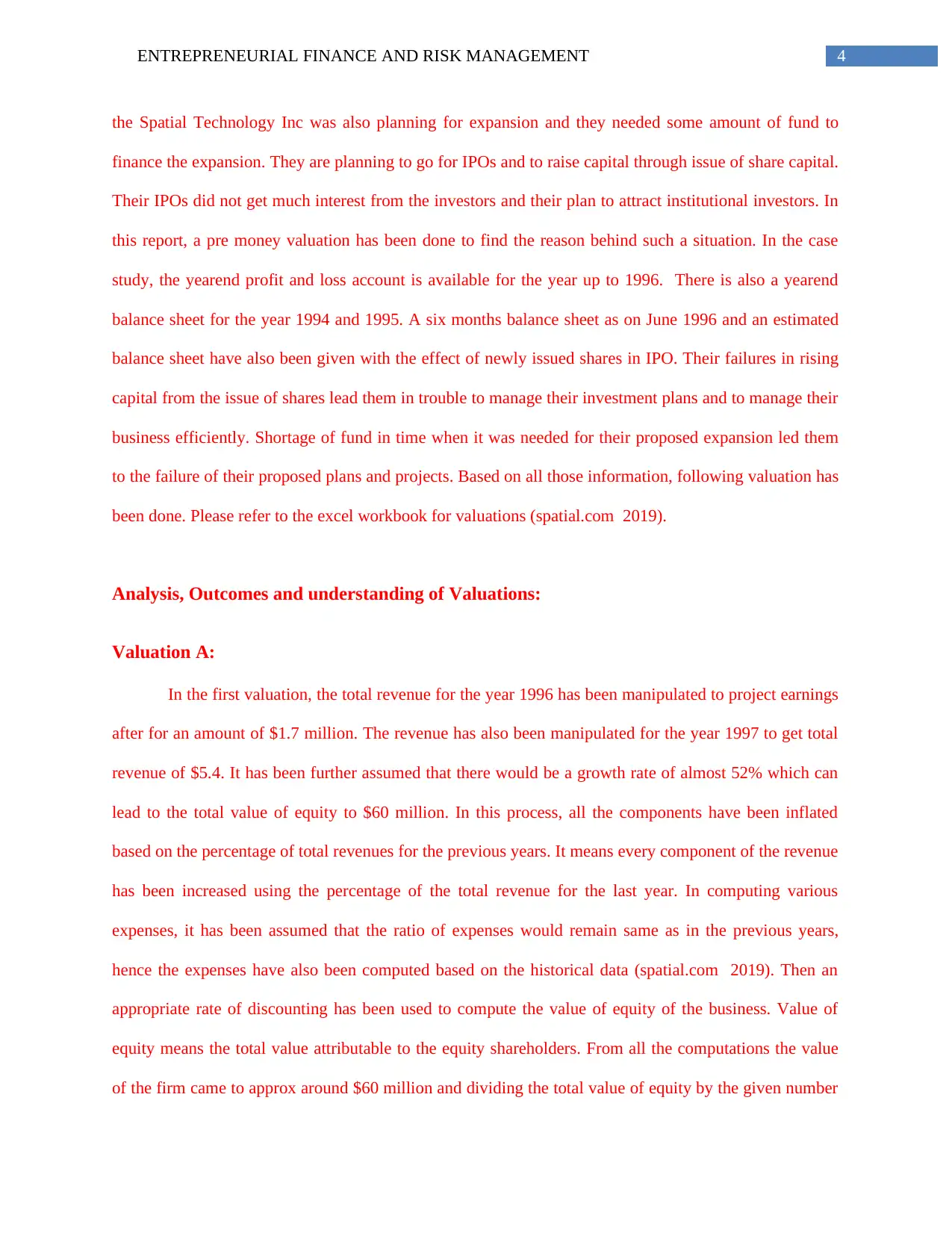
4ENTREPRENEURIAL FINANCE AND RISK MANAGEMENT
the Spatial Technology Inc was also planning for expansion and they needed some amount of fund to
finance the expansion. They are planning to go for IPOs and to raise capital through issue of share capital.
Their IPOs did not get much interest from the investors and their plan to attract institutional investors. In
this report, a pre money valuation has been done to find the reason behind such a situation. In the case
study, the yearend profit and loss account is available for the year up to 1996. There is also a yearend
balance sheet for the year 1994 and 1995. A six months balance sheet as on June 1996 and an estimated
balance sheet have also been given with the effect of newly issued shares in IPO. Their failures in rising
capital from the issue of shares lead them in trouble to manage their investment plans and to manage their
business efficiently. Shortage of fund in time when it was needed for their proposed expansion led them
to the failure of their proposed plans and projects. Based on all those information, following valuation has
been done. Please refer to the excel workbook for valuations (spatial.com 2019).
Analysis, Outcomes and understanding of Valuations:
Valuation A:
In the first valuation, the total revenue for the year 1996 has been manipulated to project earnings
after for an amount of $1.7 million. The revenue has also been manipulated for the year 1997 to get total
revenue of $5.4. It has been further assumed that there would be a growth rate of almost 52% which can
lead to the total value of equity to $60 million. In this process, all the components have been inflated
based on the percentage of total revenues for the previous years. It means every component of the revenue
has been increased using the percentage of the total revenue for the last year. In computing various
expenses, it has been assumed that the ratio of expenses would remain same as in the previous years,
hence the expenses have also been computed based on the historical data (spatial.com 2019). Then an
appropriate rate of discounting has been used to compute the value of equity of the business. Value of
equity means the total value attributable to the equity shareholders. From all the computations the value
of the firm came to approx around $60 million and dividing the total value of equity by the given number
the Spatial Technology Inc was also planning for expansion and they needed some amount of fund to
finance the expansion. They are planning to go for IPOs and to raise capital through issue of share capital.
Their IPOs did not get much interest from the investors and their plan to attract institutional investors. In
this report, a pre money valuation has been done to find the reason behind such a situation. In the case
study, the yearend profit and loss account is available for the year up to 1996. There is also a yearend
balance sheet for the year 1994 and 1995. A six months balance sheet as on June 1996 and an estimated
balance sheet have also been given with the effect of newly issued shares in IPO. Their failures in rising
capital from the issue of shares lead them in trouble to manage their investment plans and to manage their
business efficiently. Shortage of fund in time when it was needed for their proposed expansion led them
to the failure of their proposed plans and projects. Based on all those information, following valuation has
been done. Please refer to the excel workbook for valuations (spatial.com 2019).
Analysis, Outcomes and understanding of Valuations:
Valuation A:
In the first valuation, the total revenue for the year 1996 has been manipulated to project earnings
after for an amount of $1.7 million. The revenue has also been manipulated for the year 1997 to get total
revenue of $5.4. It has been further assumed that there would be a growth rate of almost 52% which can
lead to the total value of equity to $60 million. In this process, all the components have been inflated
based on the percentage of total revenues for the previous years. It means every component of the revenue
has been increased using the percentage of the total revenue for the last year. In computing various
expenses, it has been assumed that the ratio of expenses would remain same as in the previous years,
hence the expenses have also been computed based on the historical data (spatial.com 2019). Then an
appropriate rate of discounting has been used to compute the value of equity of the business. Value of
equity means the total value attributable to the equity shareholders. From all the computations the value
of the firm came to approx around $60 million and dividing the total value of equity by the given number
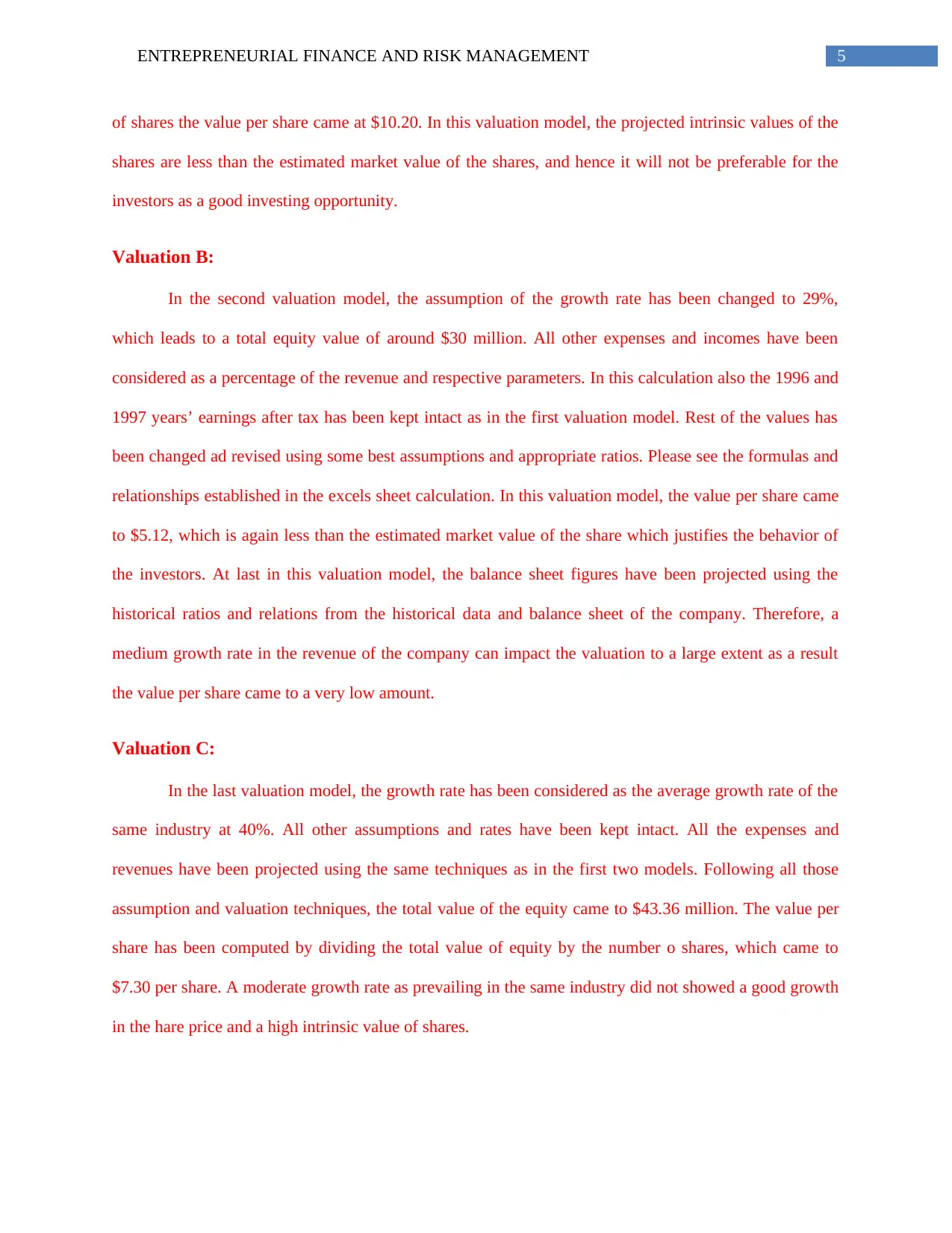
5ENTREPRENEURIAL FINANCE AND RISK MANAGEMENT
of shares the value per share came at $10.20. In this valuation model, the projected intrinsic values of the
shares are less than the estimated market value of the shares, and hence it will not be preferable for the
investors as a good investing opportunity.
Valuation B:
In the second valuation model, the assumption of the growth rate has been changed to 29%,
which leads to a total equity value of around $30 million. All other expenses and incomes have been
considered as a percentage of the revenue and respective parameters. In this calculation also the 1996 and
1997 years’ earnings after tax has been kept intact as in the first valuation model. Rest of the values has
been changed ad revised using some best assumptions and appropriate ratios. Please see the formulas and
relationships established in the excels sheet calculation. In this valuation model, the value per share came
to $5.12, which is again less than the estimated market value of the share which justifies the behavior of
the investors. At last in this valuation model, the balance sheet figures have been projected using the
historical ratios and relations from the historical data and balance sheet of the company. Therefore, a
medium growth rate in the revenue of the company can impact the valuation to a large extent as a result
the value per share came to a very low amount.
Valuation C:
In the last valuation model, the growth rate has been considered as the average growth rate of the
same industry at 40%. All other assumptions and rates have been kept intact. All the expenses and
revenues have been projected using the same techniques as in the first two models. Following all those
assumption and valuation techniques, the total value of the equity came to $43.36 million. The value per
share has been computed by dividing the total value of equity by the number o shares, which came to
$7.30 per share. A moderate growth rate as prevailing in the same industry did not showed a good growth
in the hare price and a high intrinsic value of shares.
of shares the value per share came at $10.20. In this valuation model, the projected intrinsic values of the
shares are less than the estimated market value of the shares, and hence it will not be preferable for the
investors as a good investing opportunity.
Valuation B:
In the second valuation model, the assumption of the growth rate has been changed to 29%,
which leads to a total equity value of around $30 million. All other expenses and incomes have been
considered as a percentage of the revenue and respective parameters. In this calculation also the 1996 and
1997 years’ earnings after tax has been kept intact as in the first valuation model. Rest of the values has
been changed ad revised using some best assumptions and appropriate ratios. Please see the formulas and
relationships established in the excels sheet calculation. In this valuation model, the value per share came
to $5.12, which is again less than the estimated market value of the share which justifies the behavior of
the investors. At last in this valuation model, the balance sheet figures have been projected using the
historical ratios and relations from the historical data and balance sheet of the company. Therefore, a
medium growth rate in the revenue of the company can impact the valuation to a large extent as a result
the value per share came to a very low amount.
Valuation C:
In the last valuation model, the growth rate has been considered as the average growth rate of the
same industry at 40%. All other assumptions and rates have been kept intact. All the expenses and
revenues have been projected using the same techniques as in the first two models. Following all those
assumption and valuation techniques, the total value of the equity came to $43.36 million. The value per
share has been computed by dividing the total value of equity by the number o shares, which came to
$7.30 per share. A moderate growth rate as prevailing in the same industry did not showed a good growth
in the hare price and a high intrinsic value of shares.
⊘ This is a preview!⊘
Do you want full access?
Subscribe today to unlock all pages.

Trusted by 1+ million students worldwide
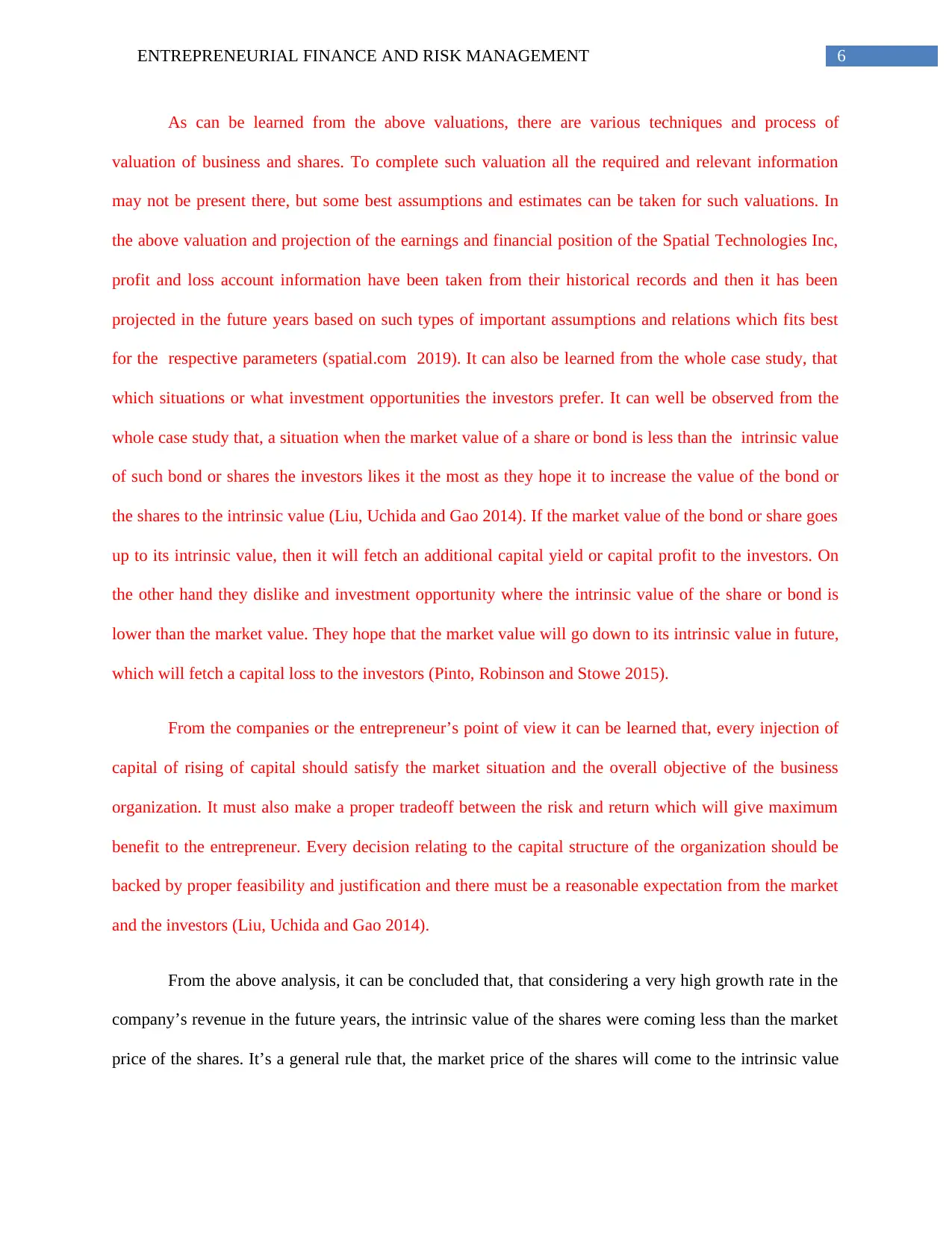
6ENTREPRENEURIAL FINANCE AND RISK MANAGEMENT
As can be learned from the above valuations, there are various techniques and process of
valuation of business and shares. To complete such valuation all the required and relevant information
may not be present there, but some best assumptions and estimates can be taken for such valuations. In
the above valuation and projection of the earnings and financial position of the Spatial Technologies Inc,
profit and loss account information have been taken from their historical records and then it has been
projected in the future years based on such types of important assumptions and relations which fits best
for the respective parameters (spatial.com 2019). It can also be learned from the whole case study, that
which situations or what investment opportunities the investors prefer. It can well be observed from the
whole case study that, a situation when the market value of a share or bond is less than the intrinsic value
of such bond or shares the investors likes it the most as they hope it to increase the value of the bond or
the shares to the intrinsic value (Liu, Uchida and Gao 2014). If the market value of the bond or share goes
up to its intrinsic value, then it will fetch an additional capital yield or capital profit to the investors. On
the other hand they dislike and investment opportunity where the intrinsic value of the share or bond is
lower than the market value. They hope that the market value will go down to its intrinsic value in future,
which will fetch a capital loss to the investors (Pinto, Robinson and Stowe 2015).
From the companies or the entrepreneur’s point of view it can be learned that, every injection of
capital of rising of capital should satisfy the market situation and the overall objective of the business
organization. It must also make a proper tradeoff between the risk and return which will give maximum
benefit to the entrepreneur. Every decision relating to the capital structure of the organization should be
backed by proper feasibility and justification and there must be a reasonable expectation from the market
and the investors (Liu, Uchida and Gao 2014).
From the above analysis, it can be concluded that, that considering a very high growth rate in the
company’s revenue in the future years, the intrinsic value of the shares were coming less than the market
price of the shares. It’s a general rule that, the market price of the shares will come to the intrinsic value
As can be learned from the above valuations, there are various techniques and process of
valuation of business and shares. To complete such valuation all the required and relevant information
may not be present there, but some best assumptions and estimates can be taken for such valuations. In
the above valuation and projection of the earnings and financial position of the Spatial Technologies Inc,
profit and loss account information have been taken from their historical records and then it has been
projected in the future years based on such types of important assumptions and relations which fits best
for the respective parameters (spatial.com 2019). It can also be learned from the whole case study, that
which situations or what investment opportunities the investors prefer. It can well be observed from the
whole case study that, a situation when the market value of a share or bond is less than the intrinsic value
of such bond or shares the investors likes it the most as they hope it to increase the value of the bond or
the shares to the intrinsic value (Liu, Uchida and Gao 2014). If the market value of the bond or share goes
up to its intrinsic value, then it will fetch an additional capital yield or capital profit to the investors. On
the other hand they dislike and investment opportunity where the intrinsic value of the share or bond is
lower than the market value. They hope that the market value will go down to its intrinsic value in future,
which will fetch a capital loss to the investors (Pinto, Robinson and Stowe 2015).
From the companies or the entrepreneur’s point of view it can be learned that, every injection of
capital of rising of capital should satisfy the market situation and the overall objective of the business
organization. It must also make a proper tradeoff between the risk and return which will give maximum
benefit to the entrepreneur. Every decision relating to the capital structure of the organization should be
backed by proper feasibility and justification and there must be a reasonable expectation from the market
and the investors (Liu, Uchida and Gao 2014).
From the above analysis, it can be concluded that, that considering a very high growth rate in the
company’s revenue in the future years, the intrinsic value of the shares were coming less than the market
price of the shares. It’s a general rule that, the market price of the shares will come to the intrinsic value
Paraphrase This Document
Need a fresh take? Get an instant paraphrase of this document with our AI Paraphraser
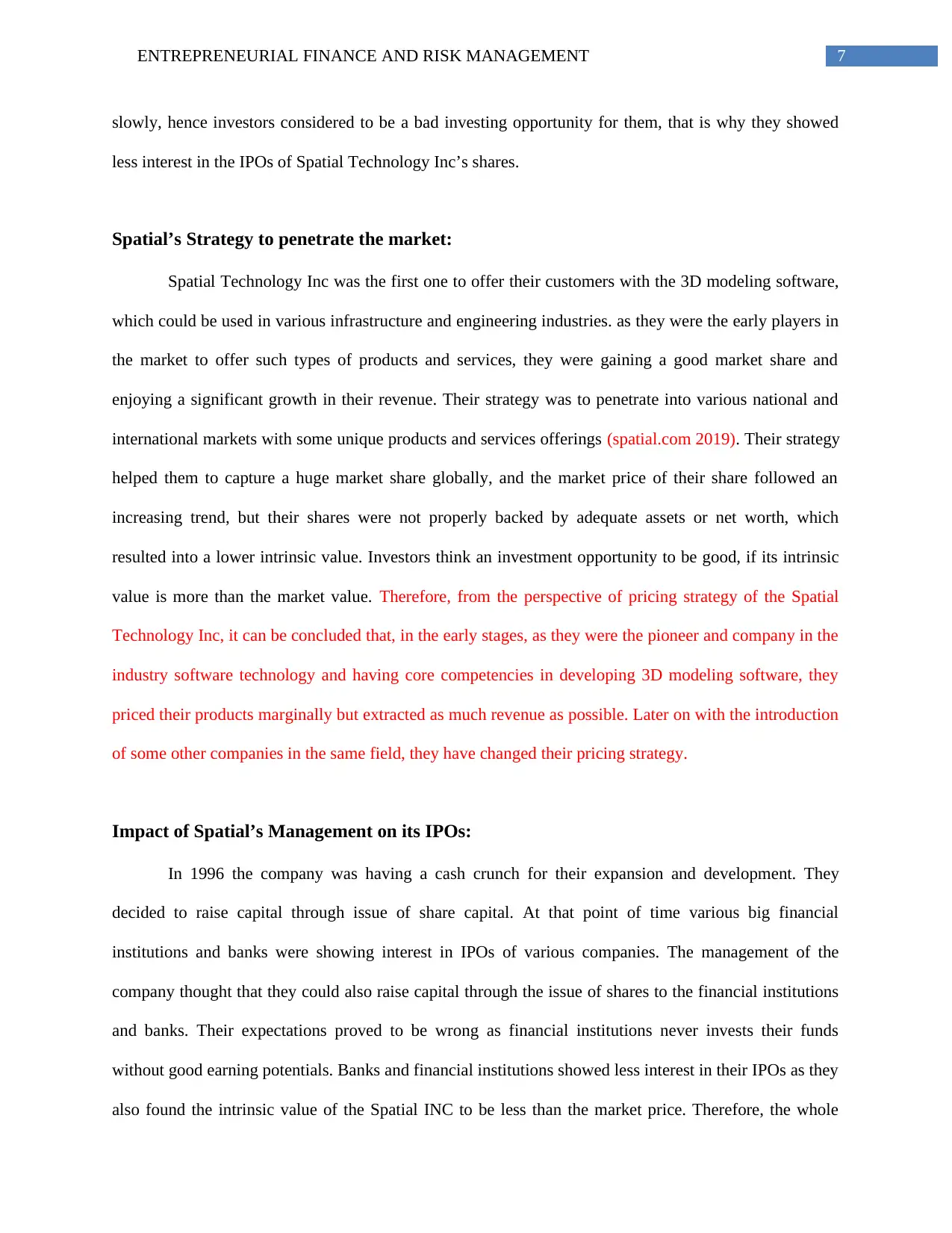
7ENTREPRENEURIAL FINANCE AND RISK MANAGEMENT
slowly, hence investors considered to be a bad investing opportunity for them, that is why they showed
less interest in the IPOs of Spatial Technology Inc’s shares.
Spatial’s Strategy to penetrate the market:
Spatial Technology Inc was the first one to offer their customers with the 3D modeling software,
which could be used in various infrastructure and engineering industries. as they were the early players in
the market to offer such types of products and services, they were gaining a good market share and
enjoying a significant growth in their revenue. Their strategy was to penetrate into various national and
international markets with some unique products and services offerings (spatial.com 2019). Their strategy
helped them to capture a huge market share globally, and the market price of their share followed an
increasing trend, but their shares were not properly backed by adequate assets or net worth, which
resulted into a lower intrinsic value. Investors think an investment opportunity to be good, if its intrinsic
value is more than the market value. Therefore, from the perspective of pricing strategy of the Spatial
Technology Inc, it can be concluded that, in the early stages, as they were the pioneer and company in the
industry software technology and having core competencies in developing 3D modeling software, they
priced their products marginally but extracted as much revenue as possible. Later on with the introduction
of some other companies in the same field, they have changed their pricing strategy.
Impact of Spatial’s Management on its IPOs:
In 1996 the company was having a cash crunch for their expansion and development. They
decided to raise capital through issue of share capital. At that point of time various big financial
institutions and banks were showing interest in IPOs of various companies. The management of the
company thought that they could also raise capital through the issue of shares to the financial institutions
and banks. Their expectations proved to be wrong as financial institutions never invests their funds
without good earning potentials. Banks and financial institutions showed less interest in their IPOs as they
also found the intrinsic value of the Spatial INC to be less than the market price. Therefore, the whole
slowly, hence investors considered to be a bad investing opportunity for them, that is why they showed
less interest in the IPOs of Spatial Technology Inc’s shares.
Spatial’s Strategy to penetrate the market:
Spatial Technology Inc was the first one to offer their customers with the 3D modeling software,
which could be used in various infrastructure and engineering industries. as they were the early players in
the market to offer such types of products and services, they were gaining a good market share and
enjoying a significant growth in their revenue. Their strategy was to penetrate into various national and
international markets with some unique products and services offerings (spatial.com 2019). Their strategy
helped them to capture a huge market share globally, and the market price of their share followed an
increasing trend, but their shares were not properly backed by adequate assets or net worth, which
resulted into a lower intrinsic value. Investors think an investment opportunity to be good, if its intrinsic
value is more than the market value. Therefore, from the perspective of pricing strategy of the Spatial
Technology Inc, it can be concluded that, in the early stages, as they were the pioneer and company in the
industry software technology and having core competencies in developing 3D modeling software, they
priced their products marginally but extracted as much revenue as possible. Later on with the introduction
of some other companies in the same field, they have changed their pricing strategy.
Impact of Spatial’s Management on its IPOs:
In 1996 the company was having a cash crunch for their expansion and development. They
decided to raise capital through issue of share capital. At that point of time various big financial
institutions and banks were showing interest in IPOs of various companies. The management of the
company thought that they could also raise capital through the issue of shares to the financial institutions
and banks. Their expectations proved to be wrong as financial institutions never invests their funds
without good earning potentials. Banks and financial institutions showed less interest in their IPOs as they
also found the intrinsic value of the Spatial INC to be less than the market price. Therefore, the whole
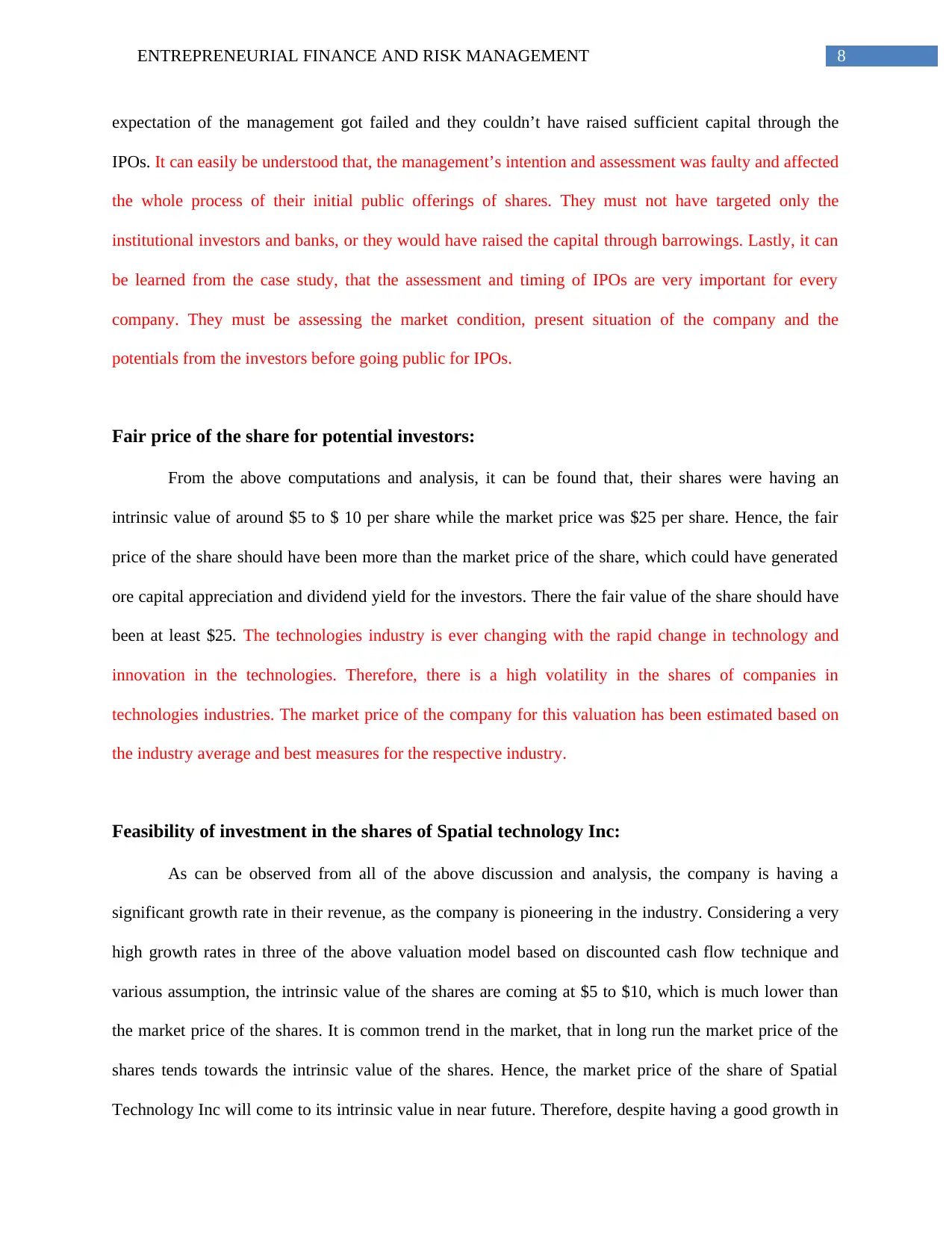
8ENTREPRENEURIAL FINANCE AND RISK MANAGEMENT
expectation of the management got failed and they couldn’t have raised sufficient capital through the
IPOs. It can easily be understood that, the management’s intention and assessment was faulty and affected
the whole process of their initial public offerings of shares. They must not have targeted only the
institutional investors and banks, or they would have raised the capital through barrowings. Lastly, it can
be learned from the case study, that the assessment and timing of IPOs are very important for every
company. They must be assessing the market condition, present situation of the company and the
potentials from the investors before going public for IPOs.
Fair price of the share for potential investors:
From the above computations and analysis, it can be found that, their shares were having an
intrinsic value of around $5 to $ 10 per share while the market price was $25 per share. Hence, the fair
price of the share should have been more than the market price of the share, which could have generated
ore capital appreciation and dividend yield for the investors. There the fair value of the share should have
been at least $25. The technologies industry is ever changing with the rapid change in technology and
innovation in the technologies. Therefore, there is a high volatility in the shares of companies in
technologies industries. The market price of the company for this valuation has been estimated based on
the industry average and best measures for the respective industry.
Feasibility of investment in the shares of Spatial technology Inc:
As can be observed from all of the above discussion and analysis, the company is having a
significant growth rate in their revenue, as the company is pioneering in the industry. Considering a very
high growth rates in three of the above valuation model based on discounted cash flow technique and
various assumption, the intrinsic value of the shares are coming at $5 to $10, which is much lower than
the market price of the shares. It is common trend in the market, that in long run the market price of the
shares tends towards the intrinsic value of the shares. Hence, the market price of the share of Spatial
Technology Inc will come to its intrinsic value in near future. Therefore, despite having a good growth in
expectation of the management got failed and they couldn’t have raised sufficient capital through the
IPOs. It can easily be understood that, the management’s intention and assessment was faulty and affected
the whole process of their initial public offerings of shares. They must not have targeted only the
institutional investors and banks, or they would have raised the capital through barrowings. Lastly, it can
be learned from the case study, that the assessment and timing of IPOs are very important for every
company. They must be assessing the market condition, present situation of the company and the
potentials from the investors before going public for IPOs.
Fair price of the share for potential investors:
From the above computations and analysis, it can be found that, their shares were having an
intrinsic value of around $5 to $ 10 per share while the market price was $25 per share. Hence, the fair
price of the share should have been more than the market price of the share, which could have generated
ore capital appreciation and dividend yield for the investors. There the fair value of the share should have
been at least $25. The technologies industry is ever changing with the rapid change in technology and
innovation in the technologies. Therefore, there is a high volatility in the shares of companies in
technologies industries. The market price of the company for this valuation has been estimated based on
the industry average and best measures for the respective industry.
Feasibility of investment in the shares of Spatial technology Inc:
As can be observed from all of the above discussion and analysis, the company is having a
significant growth rate in their revenue, as the company is pioneering in the industry. Considering a very
high growth rates in three of the above valuation model based on discounted cash flow technique and
various assumption, the intrinsic value of the shares are coming at $5 to $10, which is much lower than
the market price of the shares. It is common trend in the market, that in long run the market price of the
shares tends towards the intrinsic value of the shares. Hence, the market price of the share of Spatial
Technology Inc will come to its intrinsic value in near future. Therefore, despite having a good growth in
⊘ This is a preview!⊘
Do you want full access?
Subscribe today to unlock all pages.

Trusted by 1+ million students worldwide
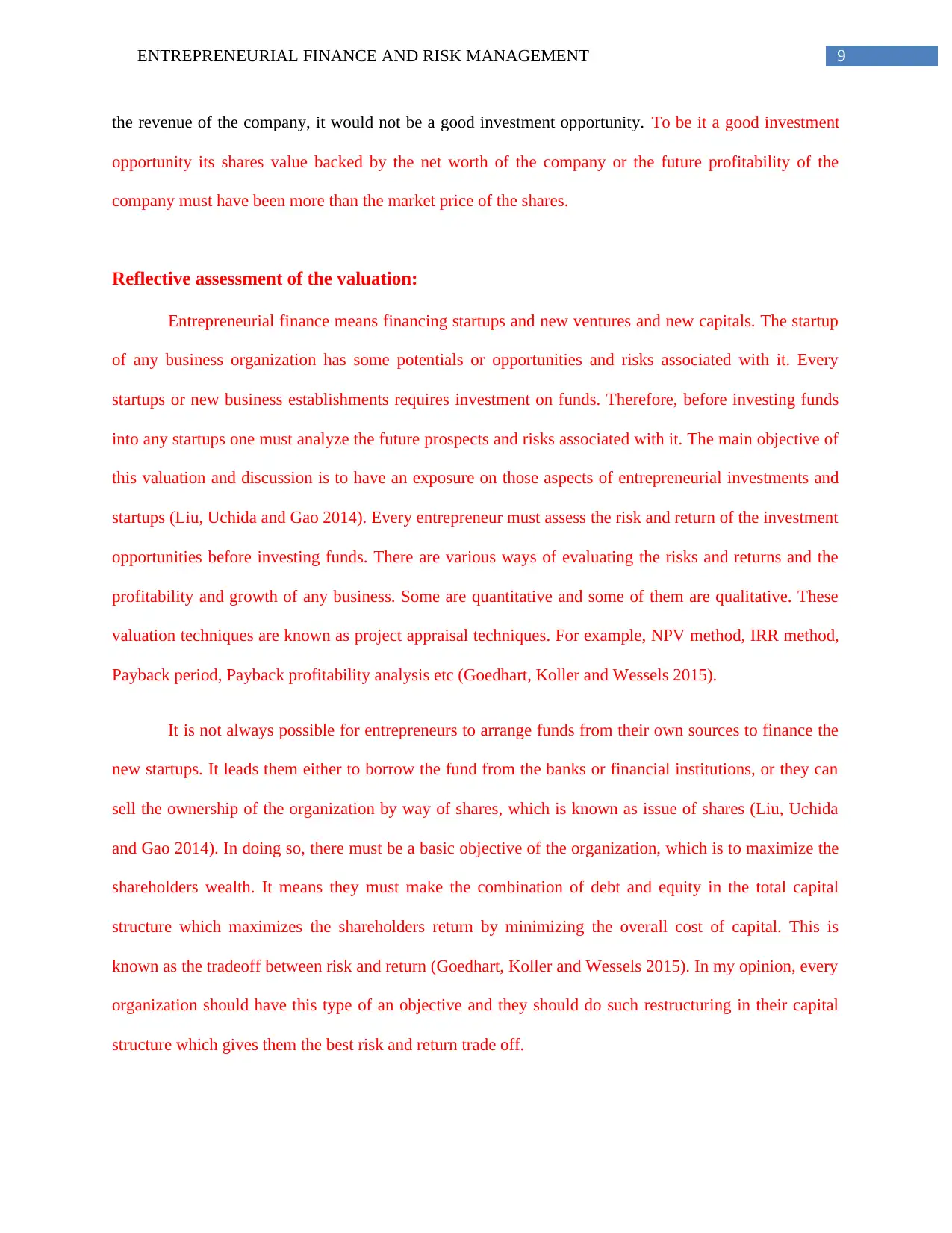
9ENTREPRENEURIAL FINANCE AND RISK MANAGEMENT
the revenue of the company, it would not be a good investment opportunity. To be it a good investment
opportunity its shares value backed by the net worth of the company or the future profitability of the
company must have been more than the market price of the shares.
Reflective assessment of the valuation:
Entrepreneurial finance means financing startups and new ventures and new capitals. The startup
of any business organization has some potentials or opportunities and risks associated with it. Every
startups or new business establishments requires investment on funds. Therefore, before investing funds
into any startups one must analyze the future prospects and risks associated with it. The main objective of
this valuation and discussion is to have an exposure on those aspects of entrepreneurial investments and
startups (Liu, Uchida and Gao 2014). Every entrepreneur must assess the risk and return of the investment
opportunities before investing funds. There are various ways of evaluating the risks and returns and the
profitability and growth of any business. Some are quantitative and some of them are qualitative. These
valuation techniques are known as project appraisal techniques. For example, NPV method, IRR method,
Payback period, Payback profitability analysis etc (Goedhart, Koller and Wessels 2015).
It is not always possible for entrepreneurs to arrange funds from their own sources to finance the
new startups. It leads them either to borrow the fund from the banks or financial institutions, or they can
sell the ownership of the organization by way of shares, which is known as issue of shares (Liu, Uchida
and Gao 2014). In doing so, there must be a basic objective of the organization, which is to maximize the
shareholders wealth. It means they must make the combination of debt and equity in the total capital
structure which maximizes the shareholders return by minimizing the overall cost of capital. This is
known as the tradeoff between risk and return (Goedhart, Koller and Wessels 2015). In my opinion, every
organization should have this type of an objective and they should do such restructuring in their capital
structure which gives them the best risk and return trade off.
the revenue of the company, it would not be a good investment opportunity. To be it a good investment
opportunity its shares value backed by the net worth of the company or the future profitability of the
company must have been more than the market price of the shares.
Reflective assessment of the valuation:
Entrepreneurial finance means financing startups and new ventures and new capitals. The startup
of any business organization has some potentials or opportunities and risks associated with it. Every
startups or new business establishments requires investment on funds. Therefore, before investing funds
into any startups one must analyze the future prospects and risks associated with it. The main objective of
this valuation and discussion is to have an exposure on those aspects of entrepreneurial investments and
startups (Liu, Uchida and Gao 2014). Every entrepreneur must assess the risk and return of the investment
opportunities before investing funds. There are various ways of evaluating the risks and returns and the
profitability and growth of any business. Some are quantitative and some of them are qualitative. These
valuation techniques are known as project appraisal techniques. For example, NPV method, IRR method,
Payback period, Payback profitability analysis etc (Goedhart, Koller and Wessels 2015).
It is not always possible for entrepreneurs to arrange funds from their own sources to finance the
new startups. It leads them either to borrow the fund from the banks or financial institutions, or they can
sell the ownership of the organization by way of shares, which is known as issue of shares (Liu, Uchida
and Gao 2014). In doing so, there must be a basic objective of the organization, which is to maximize the
shareholders wealth. It means they must make the combination of debt and equity in the total capital
structure which maximizes the shareholders return by minimizing the overall cost of capital. This is
known as the tradeoff between risk and return (Goedhart, Koller and Wessels 2015). In my opinion, every
organization should have this type of an objective and they should do such restructuring in their capital
structure which gives them the best risk and return trade off.
Paraphrase This Document
Need a fresh take? Get an instant paraphrase of this document with our AI Paraphraser
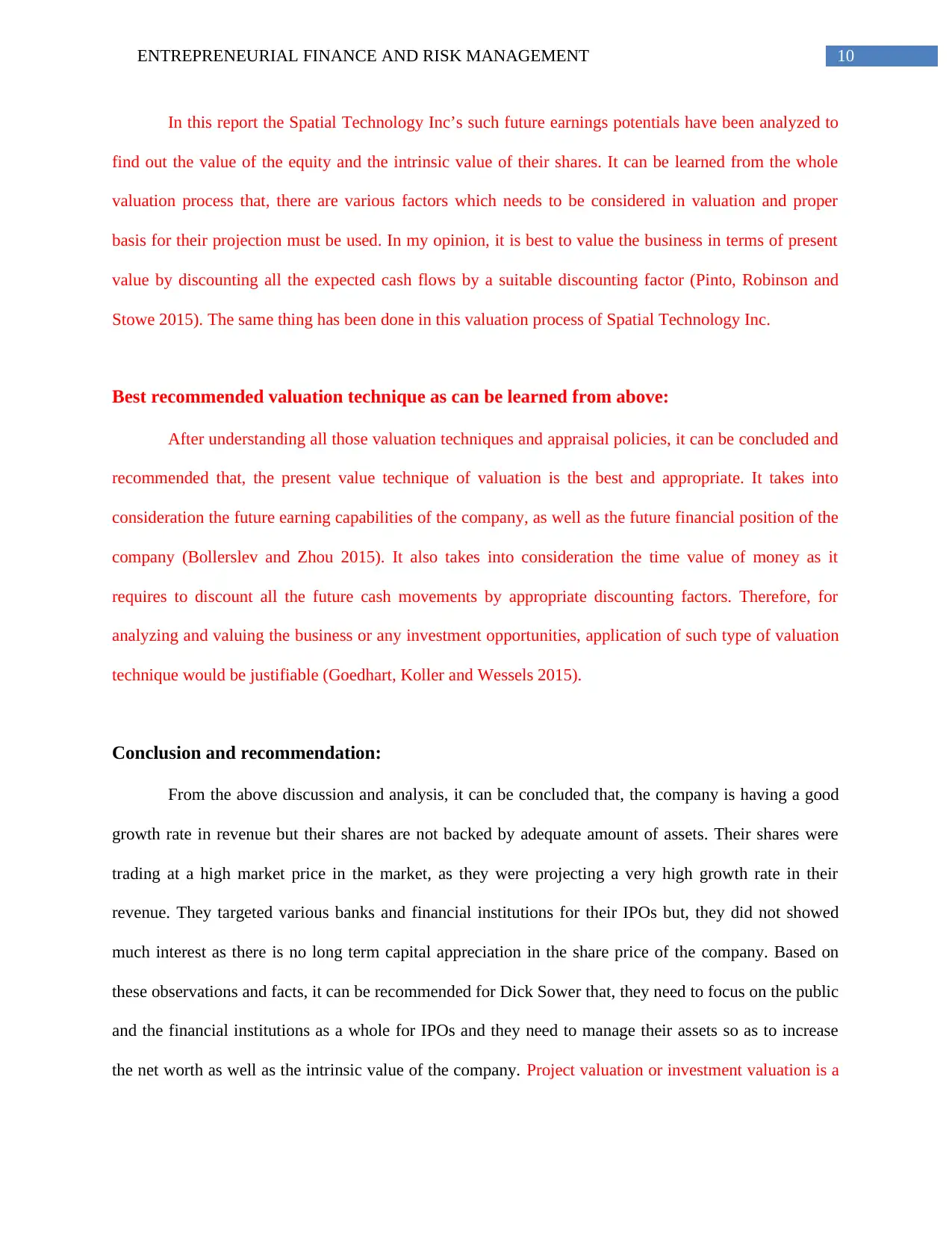
10ENTREPRENEURIAL FINANCE AND RISK MANAGEMENT
In this report the Spatial Technology Inc’s such future earnings potentials have been analyzed to
find out the value of the equity and the intrinsic value of their shares. It can be learned from the whole
valuation process that, there are various factors which needs to be considered in valuation and proper
basis for their projection must be used. In my opinion, it is best to value the business in terms of present
value by discounting all the expected cash flows by a suitable discounting factor (Pinto, Robinson and
Stowe 2015). The same thing has been done in this valuation process of Spatial Technology Inc.
Best recommended valuation technique as can be learned from above:
After understanding all those valuation techniques and appraisal policies, it can be concluded and
recommended that, the present value technique of valuation is the best and appropriate. It takes into
consideration the future earning capabilities of the company, as well as the future financial position of the
company (Bollerslev and Zhou 2015). It also takes into consideration the time value of money as it
requires to discount all the future cash movements by appropriate discounting factors. Therefore, for
analyzing and valuing the business or any investment opportunities, application of such type of valuation
technique would be justifiable (Goedhart, Koller and Wessels 2015).
Conclusion and recommendation:
From the above discussion and analysis, it can be concluded that, the company is having a good
growth rate in revenue but their shares are not backed by adequate amount of assets. Their shares were
trading at a high market price in the market, as they were projecting a very high growth rate in their
revenue. They targeted various banks and financial institutions for their IPOs but, they did not showed
much interest as there is no long term capital appreciation in the share price of the company. Based on
these observations and facts, it can be recommended for Dick Sower that, they need to focus on the public
and the financial institutions as a whole for IPOs and they need to manage their assets so as to increase
the net worth as well as the intrinsic value of the company. Project valuation or investment valuation is a
In this report the Spatial Technology Inc’s such future earnings potentials have been analyzed to
find out the value of the equity and the intrinsic value of their shares. It can be learned from the whole
valuation process that, there are various factors which needs to be considered in valuation and proper
basis for their projection must be used. In my opinion, it is best to value the business in terms of present
value by discounting all the expected cash flows by a suitable discounting factor (Pinto, Robinson and
Stowe 2015). The same thing has been done in this valuation process of Spatial Technology Inc.
Best recommended valuation technique as can be learned from above:
After understanding all those valuation techniques and appraisal policies, it can be concluded and
recommended that, the present value technique of valuation is the best and appropriate. It takes into
consideration the future earning capabilities of the company, as well as the future financial position of the
company (Bollerslev and Zhou 2015). It also takes into consideration the time value of money as it
requires to discount all the future cash movements by appropriate discounting factors. Therefore, for
analyzing and valuing the business or any investment opportunities, application of such type of valuation
technique would be justifiable (Goedhart, Koller and Wessels 2015).
Conclusion and recommendation:
From the above discussion and analysis, it can be concluded that, the company is having a good
growth rate in revenue but their shares are not backed by adequate amount of assets. Their shares were
trading at a high market price in the market, as they were projecting a very high growth rate in their
revenue. They targeted various banks and financial institutions for their IPOs but, they did not showed
much interest as there is no long term capital appreciation in the share price of the company. Based on
these observations and facts, it can be recommended for Dick Sower that, they need to focus on the public
and the financial institutions as a whole for IPOs and they need to manage their assets so as to increase
the net worth as well as the intrinsic value of the company. Project valuation or investment valuation is a

11ENTREPRENEURIAL FINANCE AND RISK MANAGEMENT
critical issue as it includes various future certainties and uncertainties. Every aspect of those things must
be considered in such type of an important investment decision making valuation.
critical issue as it includes various future certainties and uncertainties. Every aspect of those things must
be considered in such type of an important investment decision making valuation.
⊘ This is a preview!⊘
Do you want full access?
Subscribe today to unlock all pages.

Trusted by 1+ million students worldwide
1 out of 18
Related Documents
Your All-in-One AI-Powered Toolkit for Academic Success.
+13062052269
info@desklib.com
Available 24*7 on WhatsApp / Email
![[object Object]](/_next/static/media/star-bottom.7253800d.svg)
Unlock your academic potential
Copyright © 2020–2025 A2Z Services. All Rights Reserved. Developed and managed by ZUCOL.





